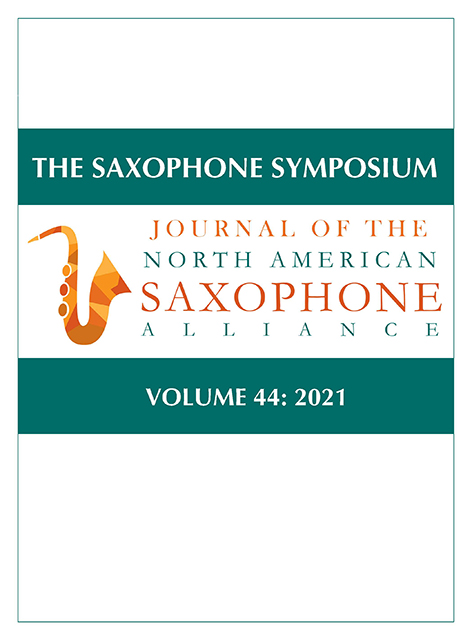Book contents
- Frontmatter
- Contents
- The Saxophone Symposium
- Nasa Executive Committee
- Notice to Contributors
- Financial Reports
- Improving the Quality of Saxophone Quartet Rehearsals: Interviews with Members of Kenari, h2, Sinta, and Fuego Quartets
- The Red Saxophone: Hanns Eisler and “Applied Music” in Weimar Berlin
- Gender Representation at North American Saxophone Alliance Biennial Conferences from 2008 through 2020
- The Raschèrian Approach: Cultivating the Elastic Bow of Articulation
- John Sampen: Biography of an American Saxophone Pioneer
- Randall Hall: Oracle
- Contributor Biographies
The Raschèrian Approach: Cultivating the Elastic Bow of Articulation
Published online by Cambridge University Press: 14 July 2023
- Frontmatter
- Contents
- The Saxophone Symposium
- Nasa Executive Committee
- Notice to Contributors
- Financial Reports
- Improving the Quality of Saxophone Quartet Rehearsals: Interviews with Members of Kenari, h2, Sinta, and Fuego Quartets
- The Red Saxophone: Hanns Eisler and “Applied Music” in Weimar Berlin
- Gender Representation at North American Saxophone Alliance Biennial Conferences from 2008 through 2020
- The Raschèrian Approach: Cultivating the Elastic Bow of Articulation
- John Sampen: Biography of an American Saxophone Pioneer
- Randall Hall: Oracle
- Contributor Biographies
Summary
Abstract
Sigurd Manfred Raschèr (1907–2001) is well known for his pioneering efforts to expand the saxophone’s range. Alongside his top-tone pursuits, Raschèr simultaneously cultivated a diverse array of articulations, redefining slap tongue and flutter tongue and their incorporation into the saxophone repertoire. The concertos by Lars-Erik Larsson, Henry Brant, and countless others embraced Raschèr’s unprecedented virtuosity, highlighting his critical role in bringing these compositions to life. However, in the present day, the notion that the dedicatee’s unique approach to articulation was a fundamental component of these works has largely been overlooked. This article examines the particular style that inspired Larsson and Brant to write for the saxophone. By analyzing Raschèr’s performances and writings, interviews with his students, musical manuscripts, and commentary from these composers, readers are offered insight into Raschèr’s performance style, the “Raschèrian” approach. With this information, performers today can develop the breadth of articulations employed in these concertos and reimagine slap tongue and flutter tongue in the twenty-first century.
Keywords: Lars-Erik Larsson, Henry Brant, Sigurd Raschèr, Slap Tongue, Flutter Tongue
Introduction: The “So-Called Slap Tongue Technique” and Flutter Tongue
Sigurd Raschèr (1907–2001), a pioneer of the saxophone’s upper register, cultivated fundamentally new approaches to articulation on the instrument throughout his career. As early as 1936, one critic recognized Raschèr’s innovative efforts, singling out the saxophonist’s use of the “s. k. slap-tongue-tekniken” (so-called slap tongue technique) after hearing him in concert. Produced by creating suction with the tongue against the reed, this percussive articulation initially gained great popularity during the vaudeville era from artists such as Rudy Wiedoeft (1893–1940). Complementing his slap tongue technique, Raschèr also sought to incorporate flutter tongue, a buzzing sound typically produced by rolling the tongue while blowing into the saxophone. Yet unlike his predecessors, Raschèr pursued a different aesthetic with these articulations, and it was this new perspective that offered composers unprecedented artistic avenues to explore with the saxophone.
In a 1938 typescript, Raschèr provided some insight into his approach regarding articulation:
The correct method to produce tonguing is to utilize the round part of the middle of the tongue for which only a very small movement is necessary.
- Type
- Chapter
- Information
- The Saxophone SymposiumJournal of the North American Saxophone Alliance, pp. 50 - 69Publisher: Boydell & BrewerFirst published in: 2023



